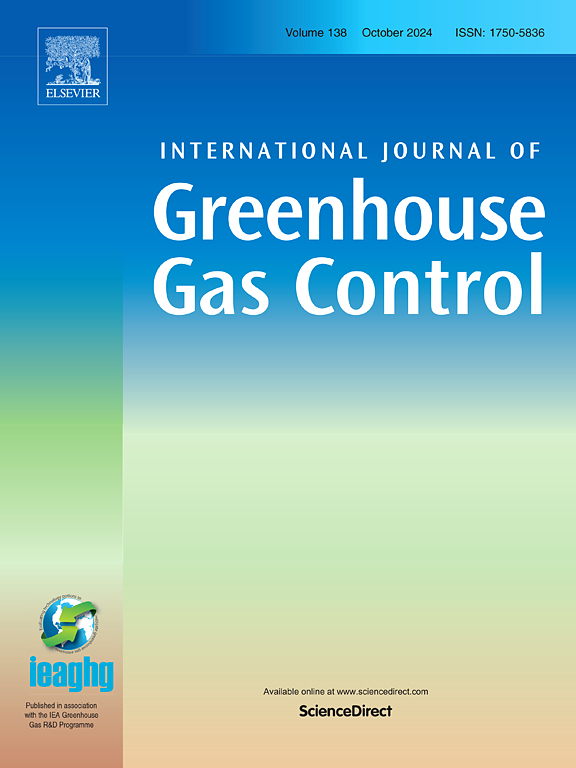氧化铝生产替代路线的研究:旨在零排放和避免铝土矿残留的Pedersen工艺与钙环的集成
IF 5.2
3区 工程技术
Q2 ENERGY & FUELS
International Journal of Greenhouse Gas Control
Pub Date : 2025-08-21
DOI:10.1016/j.ijggc.2025.104453
引用次数: 0
摘要
铝工业是一个显著的二氧化碳排放源,也是造成矿产短缺的一个重要因素。氧化铝提取通常通过拜耳工艺进行,面临两个主要挑战:使用化石燃料和产生铝土矿渣。最近提出的一种方法,Pedersen工艺,旨在通过额外的铁冶炼步骤从矿石中去除氧化铁含量,从而消除铝土矿渣的产生,从而解决这些挑战。本研究利用Pedersen工艺的原理对铝土矿生产氧化铝和生铁的材料性能和能源性能进行了评价。利用Aspen Plus软件对Pedersen工艺布局进行了不同的热力学模拟,并根据现有文献对关键参数进行了验证。此外,还评估了基于钙环的多种二氧化碳捕获配置,并进行了能源优化,以实现碳中和和零残留氧化铝生产。结果表明,对于高铝铁比铝土矿,Pedersen工艺的能源需求明显高于平均拜耳工艺,每吨产品的能源消耗估计为11.92 GJ。然而,低铝/铁比率提供更好的能源性能(每吨10.15 GJ),显示在能源消耗方面的潜在可行性。钙环化工厂的整合带来了低能耗损失,这要归功于Pedersen工厂中的CaCO3被加入钙环化工厂的净化CaO所取代。据估计,每减少一吨二氧化碳排放,能源损失至少为1.10-2.79吉焦,这显示出有利的结果,可能为更智能地利用资源和脱碳氧化铝生产铺平道路。本文章由计算机程序翻译,如有差异,请以英文原文为准。
Study of an alternative route for alumina production: Integration of calcium looping to Pedersen process aiming at zero emissions and bauxite residue avoidance
The aluminium industry is a notable emitter of CO2 and a significant contributor to mineral scarcity. Alumina extraction, typically conducted via the Bayer process, faces two main challenges: using fossil fuels and generating bauxite residue. A recently proposed approach, the Pedersen process, aims to address these challenges by removing the iron oxide content from the ore through an additional iron smelting step, thereby eliminating the generation of bauxite residue. This study evaluates the material and energy performance of alumina and pig iron co-production from bauxite using the principles of the Pedersen process. Different thermodynamic simulations of a Pedersen process layout were carried out using Aspen Plus software, and key parameters were validated against existing literature. Additionally, diverse CO2 capture configurations based on calcium looping were assessed, performing an energy optimization to achieve carbon-neutral and zero-residue alumina production.
Results indicate that the energy demand of the Pedersen process is notably higher than the average Bayer process for bauxites with high aluminium/iron ratios, with an estimated energy consumption of 11.92 GJ per tonne of products. However, low aluminium/iron ratios render better energy performances (10.15 GJ per tonne), showing potential feasibility in terms of energy consumption. The integration of a calcium-looping plant led to low energy penalties, thanks to the replacement of CaCO3 in the Pedersen plant by adding purged CaO from the calcium-looping plant. The energy penalties, estimated at a minimum of 1.10-2.79 GJ per tonne of CO2 avoided, show favourable results that could pave the way for a smarter use of resources and a decarbonized alumina production.
求助全文
通过发布文献求助,成功后即可免费获取论文全文。
去求助
来源期刊
CiteScore
9.20
自引率
10.30%
发文量
199
审稿时长
4.8 months
期刊介绍:
The International Journal of Greenhouse Gas Control is a peer reviewed journal focusing on scientific and engineering developments in greenhouse gas control through capture and storage at large stationary emitters in the power sector and in other major resource, manufacturing and production industries. The Journal covers all greenhouse gas emissions within the power and industrial sectors, and comprises both technical and non-technical related literature in one volume. Original research, review and comments papers are included.

 求助内容:
求助内容: 应助结果提醒方式:
应助结果提醒方式:


